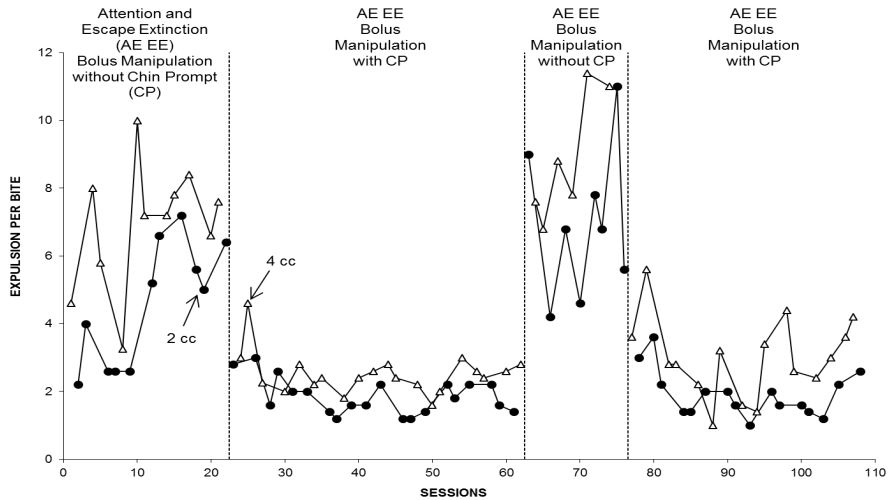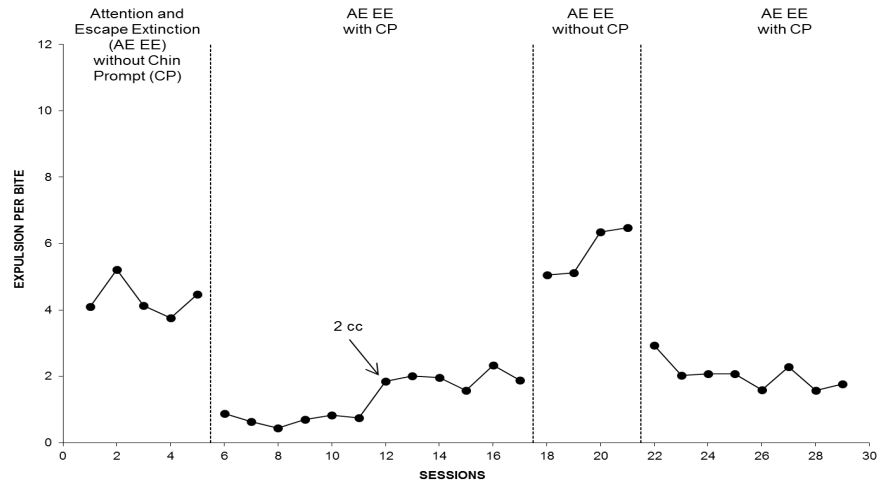Evaluation of Bolus Size and a Chin Prompt to Treat Expulsion
Conrad B. Hillman, Alessandro DiBari, Daniele Rizzi, Erica Scandurra,
Jennifer M. Kozisek, Suzanne M. Milnes, Cathleen C. Piazza
University of Nebraska Medical Center’s Munroe-Meyer Institute
Introduction
Previous research has demonstrated that manipulating the response effort associated with eating may affect feeding behaviors (e.g., acceptance, swallowing).
Kerwin, Ahearn, Eicher, and Burd (1995) showed that spoon volume was inversely correlated with levels of acceptance and mouth clean.
Wilkins, Piazza, Groff, and Vaz (2011) showed that expulsion decreased when the feeder implemented a chin prompt, which may have increased the response effort for expulsion.
In the current investigation, we extended the findings of Kerwin et al. and Wilkins et al. by using a bolus manipulation and a chin prompt to treat liquid expulsion.
Method
Participant
- Katia: 14-month-old girl diagnosed with total food and liquid refusal Setting
Setting
- 4-m by 4-m room equipped with one-way observation and sound
Dependent Variables
Expulsion: Liquid larger than a pea exiting the mouth, which we converted to expulsion per drink (number of expulsions/number of drinks that entered the mouth)
General Method
- Sessions typically consisted of 5 drink presentations
- Feeder presented cup to the child’s lips approximately every 45 s
- Feeder held the cup at the child’s lips until he or she could deposit the drink (i.e., nonremoval of the cup)
- Feeder scooped up expelled drinks and deposited them back into the child’s mouth (i.e., re-presentation)
- Sessions typically consisted of 5 drink presentations
Bolus Manipulations
- Feeder presented either a 2-cc or 4-cc bolus in each session
Chin Prompt
- During presentation and re-presentation, feeder placed his or her index finger under
the child’s chin and his or her thumb under the child’s lower lip while applying gentle,
upward pressure to close the mouth - Feeder counted audibly to 5 and discontinued the chin prompt
- During presentation and re-presentation, feeder placed his or her index finger under
Bolus Manipulation

2-cc Reversal

Result and Discussion
The 2-cc bolus was associated with lower levels of expulsion compared to the 4-cc bolus.
Expulsion decreased further when the feeder implemented the chin prompt in both the 2-cc and 4-cc bolus conditions.
These results replicate those of Kerwin et al. (1995) and Wilkins et al. (2011).
The reason for the difference in the efficacy of the chin prompt with the smaller bolus is unclear.
One reason may be that the smaller bolus size was associated with less effortful swallowing and the chin prompt was associated with more effortful expulsion.
Alternatively, the child may have lacked the oral motor skills to effectively manage the larger bolus.
In patients with poor oral-motor skills, a smaller bolus may be easier to manage and control, which may facilitate swallowing and eliminate or minimize the risk of aspiration (Logemann, 1998).
